The Sun Sagas (The Solar Cycle)
by Gene Wolfe
Reviewed by Galen Strickland
Posted June 16, 2002, with multiple edits
A purchase through our links may earn us a commission.
Other places across the 'net you will see these books referred to as Gene Wolfe's 'Solar Cycle,' but since I had already dubbed them the Sun Sagas before I realized that, I am keeping that title for this essay.
I have recently met one challenge, now I am faced with another. The first was to re-read Gene Wolfe's Book of the Long Sun, and then for the first time read his latest saga, The Book of the Short Sun. Now I need to write about these books, and I'm afraid it may take me as long. It is likely this may turn out to be even less clear than I found the books to be. Unlike Wolfe, I will not intentionally make it cryptic, but since the subject itself is very oblique that might be the fate of this essay as well. I apologize in advance for any uncertainty on my part, but I want to assure you that even if I don't understand these books completely myself, I still enjoyed them, and as soon as possible I would like to read them again. And I should warn you that what follows will inevitably contain some spoilers, but I hope they won't overwhelm you or put you off. Wolfe's stories are so dense in plot and character it would be next to impossible to discuss them without revealing quite a bit about the story. However, any that I consider major spoilers will be hidden. Don't highlight any darkened areas if this is a concern for you.
A purchase through our links may earn us a commission.
In spite of the way these works were broken up for individual publishing,
each of the series should really be considered one long novel.
"The Book of the New Sun"
Take that link to a new review page about New Sun, which is now complete.
|
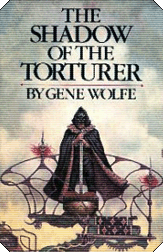 The Shadow of the Torturer (1980)
The Shadow of the Torturer (1980) |
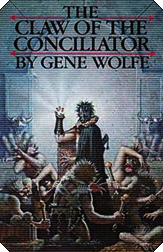 The Claw of the Conciliator (1981)
The Claw of the Conciliator (1981) |
|
A purchase through our links may earn us a commission.
|
 The Sword of the Lictor (1981)
The Sword of the Lictor (1981) |
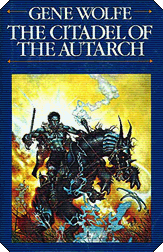 The Citadel of the Autarch (1982)
The Citadel of the Autarch (1982) |
|
A purchase through our links may earn us a commission.
A purchase through our links may earn us a commission.
"The Book of the Long Sun"
|
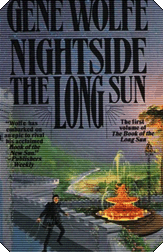 Nightside the Long Sun (1993)
Nightside the Long Sun (1993) |
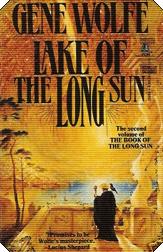 The Lake of the Long Sun (1994)
The Lake of the Long Sun (1994) |
|
A purchase through our links may earn us a commission.
|
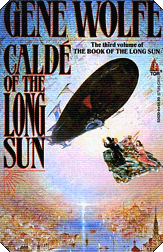 Caldé of the Long Sun (1994)
Caldé of the Long Sun (1994) |
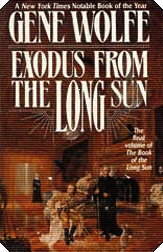 Exodus from the Long Sun (1996)
Exodus from the Long Sun (1996) |
|
A purchase through our links may earn us a commission.
"The Book of the Short Sun"
|
|
|
|
A purchase through our links may earn us a commission.
Anyone who has been a frequent visitor to this site and to the forums will know I regard Gene Wolfe very highly. There have been a few comments from others, both favorable and unfavorable. It is possible all I will accomplish with this piece is to scare people away from experiencing the wonder of Wolfe's literary accomplishments, but so be it. I feel compelled to set my thoughts down while they are still fresh in my mind. If not here, then at other places around the 'net, I have told people that Wolfe is a great but difficult read. If you read merely for escape and pleasure then he is not for you. But if you do not shirk from complex, multi-character plots that at times appear to go only in circles, and if you are not afraid to think, probe, re-read and ponder on what you read, then you may be up to the challenge.
It still amazes me that the majority of people to whom I mention Wolfe have never heard of him, much less read him. For those who haven't seen it yet, you might want to take a look at the original article I wrote about Wolfe's work. There you will see that he has been producing great SF and Fantasy for well over fifty years. He has been nominated for the Hugo or Nebula a combined twenty-six times (he's won only two Nebulas), and he won the World Fantasy Award for best novel in 1980 (for The Shadow of the Torturer, the first volume in The Book of the New Sun). Arguably, that novel is really science fiction and not fantasy, but I don't think that matters much to this discussion. These later works take place in the same universe as that novel, and on the basis of their revelations perhaps the whole saga could best be described as science fantasy. I don't want to get into a semantics debate about that issue, and I also don't want to repeat too much about his original series, The Book of the New Sun, which I described in more detail in my first article [EDIT: I've since created a new page for New Sun.
I'll give a brief re-cap though since that review is not complete yet. New Sun, originally published in four parts but now available in two volumes, takes place on Urth (it is our own Earth, but far, far down the depths of time, perhaps a million years into our future). The sun is dying; it burns a dull red, and the stars are visible even at noon. The story is told by Severian the Lame, once an apprentice in a guild of torturers, who rises to the rank of Autarch, the supreme ruler of his Commonwealth. His recollections carry us from the time he was banished from his guild through his many journeys across war-torn lands, replete with encounters with thieves and bandits, soldiers and beautiful ladies, androids and aliens, and even a god or two, or so he describes them. Severian's eventual destiny is to bring rebirth to the sun, to cleanse and renew the Urth with the cataclysm that ensues from the interaction of the sun with another white dwarf star. I consider this series to be the most compelling and beautifully written speculative fiction I have ever read.
That assessment still stands. Neither The Book of the Long Sun or The Book of the Short Sun are as good, or at least that is my opinion at this time. They were both still worth reading, but I have to admit it took Short Sun to make me appreciate Long Sun better. I'm not sure if it was the subject matter or Wolfe's approach that made me feel differently about these books. I have always been partial to first person narratives and I'm not sure why he wrote Long Sun in third person, although I might hazard a guess.
The Book of the Long Sun takes place exclusively within the confines of a generational starship, the Whorl, which set out on its journey several hundred years before Severian's time. All of the action in Long Sun (also originally four volumes, currently available in a two book set) encompasses only a few weeks time towards the end of the Whorl's journey, as it approaches its planetary destination. The main character again is one who begins in a humble position only to ascend to one of power. Patera Silk, a poor clergyman in a puzzling religion, is later chosen to be the Caldé of his city of Viron. From what I could gather, this position is somewhat of a cross between a civil mayor and a church bishop. The narrative of The Long Sun books is third person, being the recollections of Horn, a student at the palaestra (parish school) presided over by Silk and three sibyls, the Maytera's Rose, Mint, and Marble. Horn himself does not figure into the action much at all, but there is a section in the fourth book in which he slips up and writes in first person. I doubt if that was a mistake of Wolfe's, and yet I cannot figure out why he did it. Even though this was the second reading of these books for me, there are still quite a few puzzles I haven't figured out, and Short Sun only added more.
The majority of the human males of Viron derive their names from animals or products of animals, as in Silk and Horn. Other prominent characters are a Doctor Crane, a spy from a rival municipality; Blood and Musk, two criminals with whom Silk becomes involved; and Auk, another criminal who is an ally of Silk's. Female names are most often derived from plants, such as Rose and Mint, along with Chenille, Orchid, and Hyacinth (a prostitute employed by Blood who later becomes Silk's bride). These are the "bios" of the Long Sun Whorl. Maytera Marble, however, is a "chem," an android. Most chems' names are those of minerals. Others encountered by Silk are the soldiers Hammerstone, Sand, Shale, and Schist.
The religion mentioned previously is based on the worship of, and sacrifice to, several gods and goddesses, major among them being Pas and his consort Echidna. Their sons and daughters make up the rest of the pantheon, and the days of the week are named for them. The inhabitants of the Whorl are descendants of emigrants from Earth (Urth), and the environment of their man-made world is based on our own seven-day week. Pas is perhaps a manifestation of Typhon, an ancient autarch of Urth, under whose aegis the Whorl was created. The gods are said to reside in Mainframe, which is also the perceived destination of the spirits of the dead. Periodically, at least as legend tells it, these gods manifest themselves through "Sacred Windows," computer terminals placed in the manteions (chapels) throughout the Whorl. There are a few "minor" gods mentioned, the one most revered by Silk being The Outsider, who on the first page of the first book enlightens Silk with various visions of his place and mission. He is referred to as The Outsider since he brings to Silk the knowledge of the universe outside of the Whorl. I put "minor" in quotes for reasons I will explain later.
There are certain aspects to this story that do verge on fantasy, and yet over all I think it should still be considered to be a work of science fiction. It is set in the future of our own world and it involves the technologies of space flight, genetic engineering, robotics, suspended animation, and high energy weapons. Any fantastic elements can possibly be explained away by invoking Clarke's Third Law - "Any sufficiently advanced technology is indistinguishable from magic." One such phenomenon is the supposed possession of humans by the gods through the Sacred Windows, as happens at least three times during the course of this series.
What the inhabitants of the Whorl are not aware of is the existence of the Crew, those who reside in Mainframe on the outer perimeter of the cylindrical spaceship, and whose duties are the maintenance of the various machineries of the craft. The Crew refers to the other inhabitants as the Cargo, and great pains have been taken to keep the Cargo ignorant of the true nature of the Whorl. Unfortunately, much of the machinery of the Whorl is breaking down, from the air and water tunnels underneath the soil (designed to regulate the temperature and humidity of the interior) to the vast array of communication cables through which flows information from one section of The Crew to another. A regiment of flyers has been assembled, whose duty it is to patrol the skies over the many cities of the Whorl to collect information and carry it to different sections of Mainframe.
In addition to the Crew and the Cargo, there is another contingent of humans aboard the vessel; the Sleepers. The creators of the Whorl reasoned that there was a possibility the Cargo would involve themselves in conflicts which would deplete their numbers, and perhaps they would not be capable of a successful colonization of the destined planets. The Sleepers were put aboard in suspended animation, and their ranks included carefully selected types, possibly genetically-designed individuals, ones who would possess all the needed skills for such an undertaking.
Throughout the more than 1100 pages of these novels, one could sometimes get the impression that not much is happening, that Wolfe is merely padding his story with needless exposition. And yet, in retrospect, you will be amazed at how much information he has been able to impart - that is if you are able to gather together all the pieces of the puzzle. I'm forced to admit that I am still missing a few; perhaps I will find them all on the third read.
There is much dialogue here, mainly between Silk and those he encounters on his journeys, and we learn a great deal about what he feels is important. Sf critic, and Wolfe scholar, John Clute has described Silk as "a good priest in a bad religion." What he values most is truth and honesty, and he knows how to find it in the most unlikely of places. One of his main allies is a petty thief and burglar, and his eventual bride, with whom he shares a unique and abiding love, is a prostitute. The discoveries he makes about the Whorl leads him to doubt the validity of the church's teachings, and he comes to the conclusion that the only true god is The Outsider. Silk is a natural-born leader, one whom others are drawn to, one they feel compelled to follow and emulate. The goodness of Silk is most likely the reason Wolfe wrote this series in third person. Someone as good and humble as Silk would never speak of his own qualities, so the story needed to be told by one of his followers and admirers.
I have given just the slimmest of synopsis of these books, with many characters and events left for you to discover if you ever care to experience them for yourself. If I had tried to relate even half the events of this series I might still be writing this piece months from now, and I doubt if I would have been able to make things any clearer. So until now I have made no mention of Oreb, Silk's pet bird, an intelligent, talking night chough, originally purchased for sacrifice but spared when its unique abilitites are discovered, and who later figures prominently in the sequel series. There are many other things I could have touched on; the fact that Silk's manteion has been sold to the criminal Blood for back taxes, an event which propels him into a relationship with Auk, who coaches him on the techniques of breaking-and-entering so he can penetrate Blood's stronghold and plead for a reprieve; his first encounters with his future bride, Hyacinth, and with Blood's adopted daughter, Mucor, who has the ability to astrally-project her spirit and possess other humans; his discoveries of the tunnels underneath Viron and the neighboring lake-town of Limna, where he encounters the android soldier Hammerstone and awakens Mamelta, a Sleeper; his burgeoning popularity among the citizenry and his arrest by the leaders of the Ayuntamiento (the ruling council of the city) who feel his ascension to the office of Caldé will threaten their power block; the citizen revolt against the Ayuntamiento, temporarily aided by troops from the rival town of Trivigaunte who later threaten to occupy Viron; Silk's rescue, and his inauguration as Caldé; and finally the discovery of the true nature of Mainframe and the Crew, which leads to the forced embarkation of the Cargo to the planets Blue and Green. [spoiler]One other revelation I feel I must mention here concerns Quetzal, the head of Silk's religious order. Very late in the fourth book of Long Sun it is discovered that Quetzal is not human, but rather is an inhumu, a shape-shifting, blood-drinking alien species we will learn more about in the Short Sun series.[/spoiler]
As it turns out, Silk does not accompany his followers on the journey down to the planet named Blue, but rather stays aboard the Whorl with his wife Hyacinth, for reasons clear only to him and Wolfe. Horn's account of the Long Sun is written approximately two years later, as he and his wife Nettle try to reconstruct the events that led up to their exodus from the Whorl. Up to this point there is not that much that is totally confusing, other than the fact there are so many varied characters engaged in unique and complicated relationships. Wolfe also makes it difficult (intentionally I think) by revealing details very sparingly and far apart from their reference points. Without the cover or jacket blurbs for these books one might even find it difficult to realize the action is taking place on a starship rather than a planet.
A purchase through our links may earn us a commission.
This is one of the things I enjoy about Wolfe; he challenges the reader with puzzles and perhaps doesn't even care if all his clues are discovered. This is not a new style for him either; there are sections of Long Sun that reminded me of other Wolfe stories, particularly Castleview, Free Live Free, and the Latro series, Soldier of the Mist and Soldier of Arete. Elements of the Short Sun books hark back to two of his early masterpieces, the novella "The Fifth Head of Cerberus" and the novel Peace, and of course the "Sun" books come full circle to complete (possibly) the story he began in 1975 with the working title of "The Feast of Saint Catherine," which eventually became the cornerstone of The Book of the New Sun.
Twenty years pass between the conclusion of Long Sun and the beginning of Short Sun. Horn and Nettle have raised three sons (the eldest is Sinew; his twin brothers, Hoof and Hide) while creating a prosperous paper mill on Lizard Island. But the rest of the colonists on Blue do not have as good a life. Crime is rampant and political corruption threatens to throw the many city states into wars of conquest. The leading citizens of New Viron come to Horn with a request. They wish him to return to the Whorl, still in orbit of Blue's sun, and bring Silk back to lead them. They feel, and Horn agrees, that Silk is the only one who can save the planet from chaos. Word has come from another settlement of an intact lander capable of making the return voyage to the Whorl.
A purchase through our links may earn us a commission.
In the first book in the Short Sun series, On Blue's Waters, Horn (who is now writing his own story) recounts his journey by sailboat across the many seas of Blue in search of the town of Parajacou. Interspersed with his report of this journey he tells of events occuring at the time of the writing, as he is apparently in a position of authority in the town of Gaon, which is engaged in a conflict with the rival city-state of Han. Oreb, Patera Silk's talking bird re-enters the story here, but now as a companion to Horn. The reader initially assumes that Horn has brought the bird back to Blue, or perhaps Silk has brought him to the planet. But Silk is not in evidence, and casual comments by Horn seems to indicate he has failed in his task of bringing his former mentor back with him. The fact that Oreb insists on calling Horn by Silk's name is puzzling, as is when Horn makes a comment about his wife Hyacinth. Yet Horn is forced to constantly deny that he is Silk, and wonders how anyone could mistake him for Silk.
Many new, intriguing characters are introduced in this first sequel novel, beginning with Seawrack, apparently a human female who has been held captive under the ocean by a creature she calls Mother, reminiscent of the underwater undines encountered by Severian on Urth in The Book of the New Sun. Horn also encounters The Neighbors (also known as the Vanished People), members of the original sentient species native to Blue. Most humans think the Neighbors are extinct, but Horn learns the majority of them have transcended the physical plane and reside in the ether of nearby space. In a noble gesture of sympathy, Horn proclaims for all his people that the Neighbors will always be welcome to return to visit their homeworld.
Another character we meet is an inhumu named Krait, with whom Horn develops an uneasy alliance. The inhumu are the native species of the planet Green. They are not only able to fly, they also can transport themselves through the airless void between the planets. The inhumu share many of the traits of the fabled vampire, able to transform themselves into different shapes, including convincing mimicry of humans. Like vampires, they feed on the blood of their victims and hunt at night. One of the most confusing things about this relationship is why Horn tolerates Krait's presence. There are things about the inhumu that Horn learns later which causes him to be more sympathetic to their plight, but this does not explain his earlier truce, and in some cases his verbal and physical defense of Krait. By the time of the action in the state of Gaon, Krait is already dead, a scene to which Horn alludes in just the vaguest of manners several times, and yet one which we will learn is most significant. Since the books are written in such a disjointed pattern, we read of Horn's actions which are based on information he has learned in his past, but which he has yet to reveal in his narrative. He teases us on numerous occasions about a secret of the inhumu, revealed to him by Krait as he lay dying, but which he does not completely explain until very late in the third book, Return to the Whorl (and which I will not reveal here).
A purchase through our links may earn us a commission.
The second book, In Green's Jungles, is perhaps the most important part of this novel, one I will have to re-read most carefully next time. I am convinced I missed a few (or many) important clues which would have helped unravel and decipher many puzzling elements. Even though you would expect that most of the action would be taking place on that planet, Horn actually spends as much time discussing his actions in another township on Blue as it prepares for battle with another warlord. Another inhumu, female this time, figures prominently in this section, and on many occasions Horn protects and defends her in much the same manner as he did with Krait. The few scenes actually set on Green are very confusing, at least to me. There are several human settlements there established by other emigrants from the Whorl, but there are also many humans who have been captured and enslaved by the inhumu, inlcuding Auk and Chenille, former comrades of Silk's. The turning point of this novel, and of the entire series, comes with [spoiler]Horn's death, or un-death, depending on how you wish to perceive it. Following a pitched battle with the inhumu and their slaves, Horn is fatally wounded. He is comforted and aided by the Neighbors, who apparently transport Horn's spirit into the body of Silk thousands of miles away on the Whorl. Horn comes back to consciousness on his knees before the body of a woman we assume to be Hyacinth. His arms and hands are bleeding from apparently self-inflicted wounds. He drops a heavy knife to the floor, stands up, and walks out into the light of the Long Sun.[/spoiler]
Again, there are far too many elements to this series to adequately deal with in an article of this nature. I am not going to attempt a synopsis of Return to the Whorl, as its revelations are even more confusing than what has gone before. One could spend years and write entire books analyzing Wolfe's complex tales, but I will attempt to wrap this up with a discussion of a few of the major themes. First, what seems to occupy the majority of Wolfe's work are the twin themes of memory and identity. Severian possesses an eidetic memory, unable to forget even the most minor of his life's details; Latro, from the Soldier series, is cursed by a goddess into recurring amnesia, unable to recall anything for longer than a day at a time. The protagonist of "The Fifth Head of Cerberus" is a clone, doomed to repeat the trials and failures of his predecessors - or is he actually a member of the shape-shifting aboriginal culture of the sister planet? Those shape-shifters from the Cerberus stories bear a striking resemblance (other than the blood-drinking) to the native species of Green in Short Sun. I have even read speculation that Horn/Silk (or at least the person who is relating the story) is an inhumu. There is a scene, I believe it is in In Green's Jungles, where Horn tells his son Sinew to beware anyone who eats very little, as the inhumu prefer to feast only on blood at night. What he seems to have forgotten is that just a few pages before he has told us that he has gone days without eating and remains free of hunger. This again reminds me much of the situation in "The Fifth Head of Cerberus," wherein it was possible to believe that most of the characters were actually the shape-shifting aborigines who had transformed themselves into humans to expiate the guilt they felt for their genocide.
Wolfe also frequently deals with complex moral and religious matters. Silk is perhaps the most saintly of characters ever to appear in a science fiction novel. Both Severian and Silk (or Horn/Silk) can be perceived to be Christ-like figures. The Outsider, as envisioned by Silk, is the God, whom Severian referred to as the Increate, the creator of all nature. John Clute speculated, albeit prematurely in his review of the second novel of this series, that the Outsider was in fact Severian, but I am sure Wolfe never intended to imply that. Silk/Horn is more likely to be closer to that level of godhood, as he has discovered a method (with the aid of the Neighbors and the inhumu) of transporting his spirit across space. On several occasions he journeys thusly back to Urth, and encounters the young Severian, who tells him that he will not mention him in the story of his life that he will write (The Book of the New Sun), because "no one would believe me." Thus we learn that Short Sun ends at approximately the same time that New Sun began. The whole saga concludes with Silk/Horn's stated intention of returning to Urth, and perhaps he figures in some way in the plot of Severian's tale, or so Wolfe implied in a recent interview.
A purchase through our links may earn us a commission.
In conclusion, these are great books, full of profound and complex ideas, some of the best literature I have ever read. But at the same time I cannot recommend them whole-heartedly to just anyone. You must be convinced that SF can be serious, that it can be more than just entertainment. Also, please bear in mind who is writing this article. I am the one who has stated on several occasions that the best book I have ever read is Star Maker by Olaf Stapledon, certainly one of the most complex and difficult-to-read SF novels ever published, or ever attempted for that matter.
Wolfe takes SF seriously, of that I am sure. And I love him for it.
We would appreciate your support for this site with your purchases from
Amazon.com and ReAnimusPress.